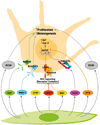Participation of keratinocyte- and fibroblast-derived factors in melanocyte homeostasis, the response to UV, and pigmentary disorders
- PMID: 33973367
- PMCID: PMC8906239
- DOI: 10.1111/pcmr.12985
Participation of keratinocyte- and fibroblast-derived factors in melanocyte homeostasis, the response to UV, and pigmentary disorders
Abstract
Human epidermal melanocytes play a central role in sensing the environment and protecting the skin from the drastic effects of solar ultraviolet radiation and other environmental toxins or inflammatory agents. Melanocytes survive in the epidermis for decades, which subjects them to chronic environmental insults. Melanocytes have a poor self-renewal capacity; therefore, it is critical to ensure their survival with genomic stability. The function and survival of melanocytes is regulated by an elaborate network of paracrine factors synthesized mainly by epidermal keratinocytes and dermal fibroblasts. A symbiotic relationship exists between epidermal melanocytes and keratinocytes on the one hand, and between melanocytes and dermal fibroblasts on the other hand. Melanocytes protect epidermal keratinocytes and dermal fibroblasts from the damaging effects of solar radiation, and the latter cells synthesize biochemical mediators that maintain the homeostasis, and regulate the stress response of melanocytes. Disruption of the paracrine network results in pigmentary disorders, due to abnormal regulation of melanin synthesis, and compromise of melanocyte survival or genomic stability. This review provides an update of the current knowledge of keratinocyte- and fibroblast-derived paracrine factors and their contribution to melanocyte physiology, and how their abnormal production is involved in the pathogenesis of common pigmentary disorders.
Keywords: DNA damage response; melanocytes; paracrine factors; pigmentary disorders; solar UV.
© 2021 John Wiley & Sons A/S. Published by John Wiley & Sons Ltd.
Conflict of interest statement
CONFLICT OF INTEREST
The authors declare no conflict of interest.
Figures



Similar articles
-
Precise role of dermal fibroblasts on melanocyte pigmentation.J Dermatol Sci. 2017 Nov;88(2):159-166. doi: 10.1016/j.jdermsci.2017.06.018. Epub 2017 Jul 1. J Dermatol Sci. 2017. PMID: 28711237 Review.
-
Keratinocytes and fibroblasts in a human skin equivalent model enhance melanocyte survival and melanin synthesis after ultraviolet irradiation.J Invest Dermatol. 1995 May;104(5):859-67. doi: 10.1111/1523-1747.ep12607034. J Invest Dermatol. 1995. PMID: 7738368
-
Endothelin-1 is a transcriptional target of p53 in epidermal keratinocytes and regulates ultraviolet-induced melanocyte homeostasis.Pigment Cell Melanoma Res. 2013 Mar;26(2):247-58. doi: 10.1111/pcmr.12063. Epub 2013 Jan 24. Pigment Cell Melanoma Res. 2013. PMID: 23279852 Free PMC article.
-
[Culture of human melanocytes. Its contribution to the knowledge of melanocyte physiology].Pathol Biol (Paris). 1992 Feb;40(2):114-20. Pathol Biol (Paris). 1992. PMID: 1608652 Review. French.
-
Impact of ultraviolet radiation on dermal and epidermal DNA damage in a human pigmented bilayered skin substitute.J Tissue Eng Regen Med. 2019 Dec;13(12):2300-2311. doi: 10.1002/term.2959. Epub 2019 Nov 17. J Tissue Eng Regen Med. 2019. PMID: 31502756
Cited by
-
The Keratinocyte in the Picture Cutaneous Melanoma Microenvironment.Cancers (Basel). 2024 Feb 23;16(5):913. doi: 10.3390/cancers16050913. Cancers (Basel). 2024. PMID: 38473275 Free PMC article. Review.
-
The Skin-Lightening Power of Tirbanibulin 1% Ointment.Dermatol Ther (Heidelb). 2025 Jan;15(1):95-110. doi: 10.1007/s13555-024-01310-0. Epub 2024 Nov 30. Dermatol Ther (Heidelb). 2025. PMID: 39614963 Free PMC article.
-
ROS and calcium signaling are critical determinant of skin pigmentation.Cell Calcium. 2025 Jan;125:102987. doi: 10.1016/j.ceca.2024.102987. Epub 2024 Dec 20. Cell Calcium. 2025. PMID: 39708588 Free PMC article. Review.
-
Comparative Analysis of Olive-Derived Phenolic Compounds' Pro-Melanogenesis Effects on B16F10 Cells and Epidermal Human Melanocytes.Int J Mol Sci. 2024 Apr 19;25(8):4479. doi: 10.3390/ijms25084479. Int J Mol Sci. 2024. PMID: 38674064 Free PMC article.
-
Lrig1- and Wnt-dependent niches dictate segregation of resident immune cells and melanocytes in murine tail epidermis.Development. 2022 Jul 15;149(14):dev200154. doi: 10.1242/dev.200154. Epub 2022 Jul 14. Development. 2022. PMID: 35815643 Free PMC article.
References
-
- Alicea GM, Rebecca VW, Goldman AR, Fane ME, Douglass SM, Behera R, Webster MR, Kugel CH, Ecker BL, Caino MC, Kossenkov AV, Tang H-Y, Frederick DT, Flaherty KT, Xu X, Liu Q, Gabrilovich DI, Herlyn M, Blair IA … Weeraratna AT (2020). Changes in Aged Fibroblast Lipid Metabolism Induce Age-Dependent Melanoma Cell Resistance to Targeted Therapy via the Fatty Acid Transporter FATP2. Cancer Discovery, 10, 1282–1295. 10.1158/2159-8290.CD-20-0329 - DOI - PMC - PubMed
Publication types
MeSH terms
Grants and funding
LinkOut - more resources
Full Text Sources
Other Literature Sources
Medical

